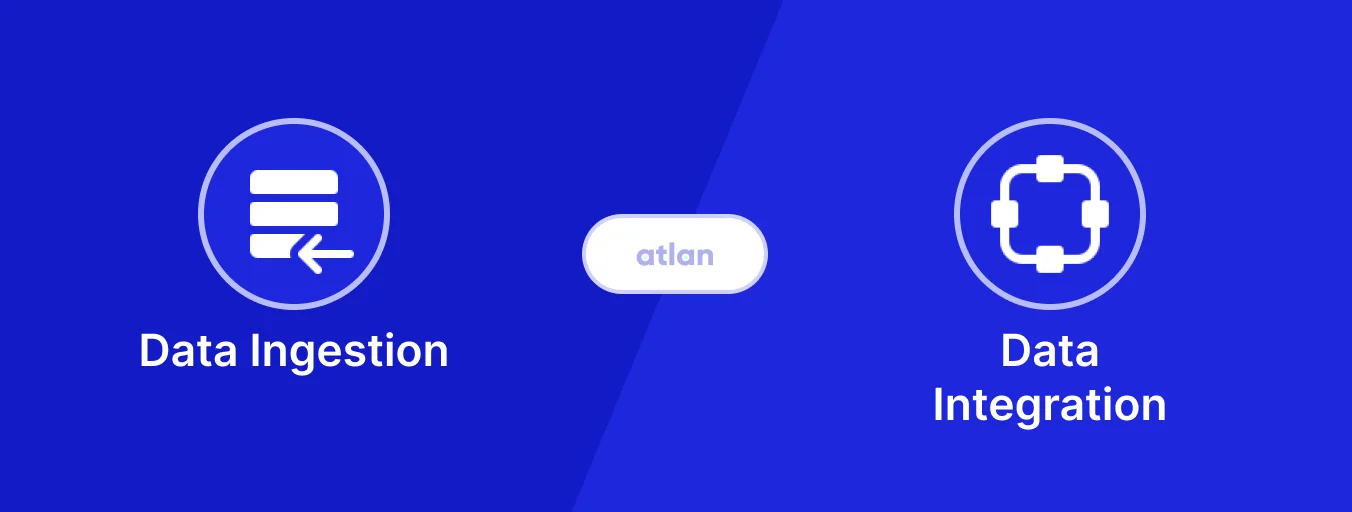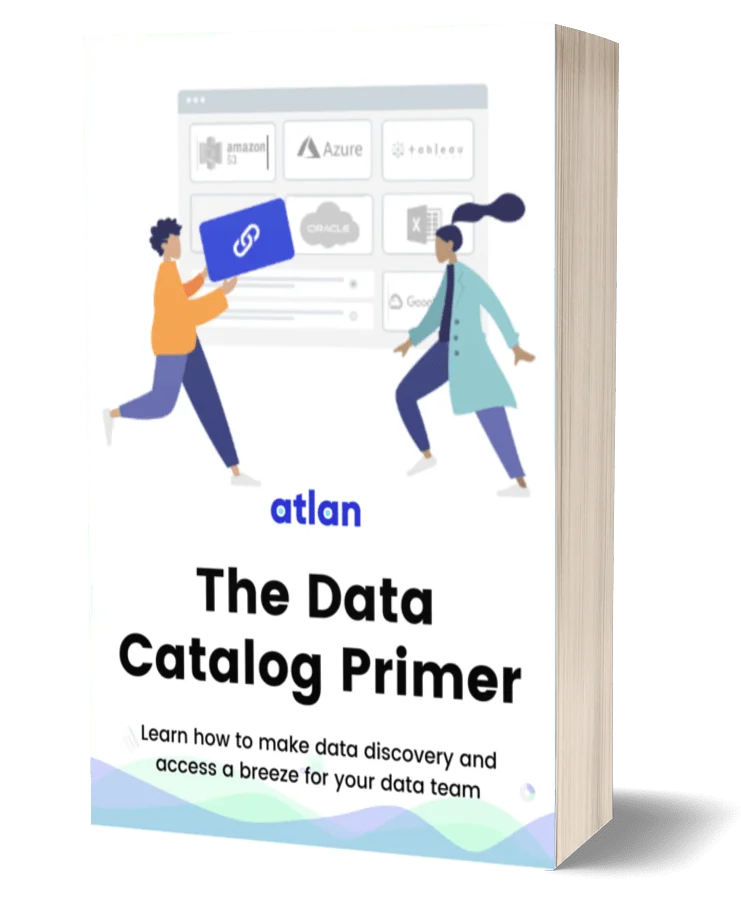Data Ingestion vs. Data Integration: How Are They Different?

Share this article
As organizations aim to gain timely insights from large volumes of real-time data, they should ensure that their data ingestion and integration pipelines run seamlessly.
However, the two data terminologies are often used interchangeably, leading to queries, such as “data ingestion vs. data integration” and “are data ingestion and data integration the same?”.
This article will settle the data ingestion vs. data integration debate by highlighting their interrelationships and differences.
Let’s start with data ingestion.
What is data ingestion? #
Data ingestion refers to the process of collecting raw data from disparate sources and transferring that data to a centralized repository — database, data warehouse, data lake, or data mart.
Data ingestion is the first step in setting up a robust data delivery pipeline. It moves data from source A to target B with no modifications or transformations. It also doesn’t verify any conditions, quality issues, or data policy rules.
Once data ingestion is done successfully, data teams can begin processing and analyzing data to extract useful insights.
For example, a data ingestion pipeline can fetch data from audio or video files, documents, clickstreams, IoT devices, and SaaS applications and load it in Elasticsearch. This enables data teams to run full-text searches across the data ecosystem.
Let’s look at the different types of data ingestion techniques.
Types of data ingestion #
Data ingestion usually occurs in three ways:
- Batch data ingestion: Data is periodically collected and transferred from input sources to target storage in batches. Data can also be ingested based on trigger events. With batch processing, high latency data transfers can take up to a few minutes.
- Streaming data ingestion: Data is collected and transferred from source to destination in real-time. Streaming data ingestion is ideal for time-sensitive data like stock market analysis, industrial sensors, or application logs. Streaming data ingestion offers low latencies in milliseconds.
- Hybrid data ingestion: Also referred to as lambda architecture, hybrid data ingestion combines batch data and streaming data ingestion methods. It consists of a batch layer and a speed layer (real-time) to handle each type of data ingestion.
Now let’s look at data integration.
What is data integration? #
Data integration refers to the process of unifying data from multiple sources to gain a more valuable view of it, enabling businesses to make data-informed decisions.
Here’s how Gartner defines data integration:
The discipline of data integration comprises the practices, architectural techniques and tools for achieving the consistent access and delivery of data across the spectrum of data subject areas and data structure types in the enterprise to meet the data consumption requirements of all applications and business processes.
Let’s explore the process of data integration:
- In the first step, you ingest raw data — structured, unstructured, or semi-structured — from various data sources such as transactional applications, ERP applications, APIs, or IoT sensors. That data also comes in various formats, such as XML and JSON.
- After gathering that data, you consolidate it by applying various transformations such as aggregation, cleaning, merging, filtering, binning, and more.
- Finally, you import the modified data into the destination, which is a repository like a database, data warehouse, or data lake, where you can analyze it using visualization tools like Tableau, Sisense, and Qlik.
An effective data integration process ensures that data is ready for reporting and business analytics. The process includes:
- Data ingestion
- ETL (Extract, Transform, Load) or ELT (Extract, Load, Transform) pipelines
- Metadata management
- Data quality management
- Security and data governance
Similar to data ingestion, there are different types of data integration.
Types of data integration processes #
Data integration can be done in:
- Batches: Data is extracted, cleansed, transformed, and loaded into destination storage like a data warehouse in batches.
- Real-time: Data integration processes are applied to time-sensitive data in real-time, offering low latency data pipelines.
Next, let’s look at tools that enable data ingestion and data integration.
Tools for data ingestion and data integration #
While there are distinct tools for ingestion and integration, many data tools offer overlapping features, as data integration includes the data ingestion process.
However, here are the characteristics of tools for each process:
- Data ingestion tools
- They support raw data transfer from source to destination.
- Examples include Apache Kafka, Apache Nifi, Wavefront, Funnel, and Amazon Kinesis. These tools specialize in fast data transfers for high-performance data pipelines.
- Data integration tools
- They apply various data integration processes to raw data and then store it in a warehouse.
- Examples include Fivetran, Alteryx, Pentaho, and Azure Data Factory.
Another aspect to note is the rising popularity of cloud-based tools for ingestion and integration.
Gartner recommends that data and analytics technical professionals must adopt a data ingestion framework that is extensible, automated, and adaptable. Cloud platforms enable this aspect. As a result, the modern data stack uses cloud-based data ingestion and integration tools to support rapid scalability.
On-premise data tools are still in use, but it largely depends on an organization’s data strategy.
Now, let’s compare data ingestion vs. data integration.
Data ingestion vs. data integration: Overlapping yet different #
As we discussed earlier, data ingestion collects and transports data from source to destination. Meanwhile, data integration applies various data transformations to improve data quality and enable data teams to extract valuable business analytics from a central data repository.
In the table below, let’s summarize other differences to compare data ingestion vs. data integration.
| Aspect | Data Ingestion | Data Integration |
|---|---|---|
| Definition | Data ingestion involves collecting and transferring data from various input sources to the target storage for further processing. | Data integration unifies raw data from disparate sources, applies transformations, and loads it into a data warehouse or lake. |
| Use | Ingestion consolidates data from various sources in a central repository for further processing. | Integration ensures that high-quality, credible data is available for analytics and reporting. |
| Data quality | Ingestion doesn’t automatically ensure data quality. | Integration improves data quality by applying various data transformations like merging and filtering. |
| Complexity | Data ingestion pipelines are less complex, when compared with integration pipelines. | Data integration pipelines are more complicated because they involve data cleansing, ETL, metadata management, governance, and other processes. |
| Coding and domain expertise | Ingestion isn’t a complex process as compared to data integration. So, it doesn’t require engineers with vast domain knowledge and experience. | Data integration requires skilled data engineers or ETL developers who can write scripts to extract and transform data from disparate sources. |
Data ingestion + data integration: Ready to build a modern data stack? #
Data ingestion and data integration are essential parts of a modern data stack as they enable data democratization throughout the organization.
However, the lines seem to be blurring. For instance, Gartner states that the separate and distinct data integration tool submarkets — replication tools, data federation (EII), data quality tools, data modeling — seem to be converging at the vendor and technology levels.
Here’s how McKinsey envisions the data-driven organization of 2025:
Everyone will naturally and regularly leverage data to support their work. Even the most sophisticated advanced analytics will be reasonably available to all organizations as the cost of cloud computing continues to decline and more powerful “in-memory” data tools come online.
For that to happen, the future of data integration tools would lead to holistic platforms that integrate the various data integration capabilities.
To learn more about emerging data trends, check out Atlan’s in-depth resource on future of modern data stack in 2023.
Photo by Sabrina Gelbart from Pexels
Share this article










